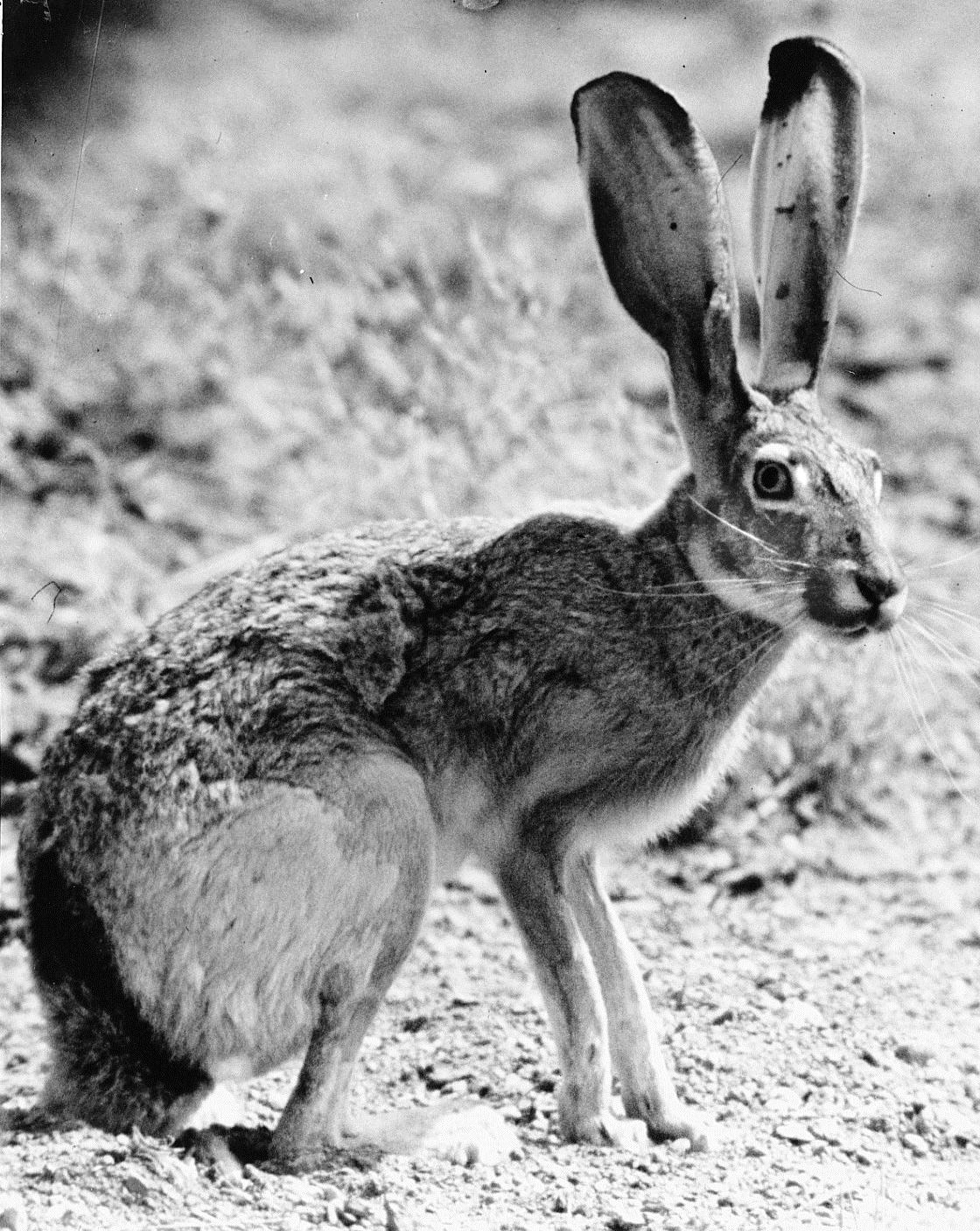BLACK-TAILED JACKRABBIT
Lepus californicus Gray 1837
DESCRIPTION. A large, long-eared rabbit of the open grasslands and desert scrub of the West; color of sides differentiated but little, if at all, from color of the back; ear nearly as long as the hind foot, with black patch at tip; top of tail with black stripe that extends onto rump; underparts clear, ochraceous buff, paler medially; upperparts dark buff, heavily sprinkled with blackish. Averages for external measurements: total length, 604 mm; tail, 95 mm; hind foot, 131 mm; ear, 125 mm. Weight, 1.5-4 kg.

DISTRIBUTION. Statewide, except for Big Thicket region of extreme southeastern Texas.

SUBSPECIES. Lepus c. melanotis in the north, L. c. merriami in the south and southeast, and L. c. texianus on the western Edwards Plateau and in the Trans-Pecos. This species is in need of taxonomic review.
HABITS. The black-tailed jackrabbit is a common inhabitant of the hot, dry desert scrubland. It occupies an elevational range from sea level to >2,500 m (8200 ft.) on the southwest slopes of some of the desert mountains but seldom inhabits coniferous forests (pinyon pine and juniper areas excepted), although occasionally it may stray into them.
In summer, this rabbit spends the hotter part of the day dozing in a bed scratched out at the base of some shrub or in a clump of tall grass where the shade will protect it from the hot sun. In winter, such beds are located in vegetation that offers protection from the chilling winds. It becomes active at twilight and forages well into the night. When disturbed, it depends on speed and its keen senses of hearing and sight to elude predators.
The food includes forage crops, cactus, sagebrush, mesquite, and numerous grasses and herbs. Because of a preference for sparsely vegetated areas, this species often concentrates in pastures overgrazed by livestock, further depleting the vegetation. It has been estimated that 128 black-tailed jackrabbits can consume as much range vegetation as one cow or seven sheep. Thus, when these rabbits are concentrated, often as many as 154 per square kilometer, they conflict with grazing interests. Such concentrations frequently result from overgrazing; hence, ranchers should recognize an overabundance of jackrabbits as an indication of overstocking.
The breeding season extends throughout the year in Texas. Two to six litters of one to six young may be produced each year. The gestation period is 41-47 days. The young are precocious and active shortly after birth. They grow rather rapidly and reach adult size in about 7-8 months. Sexual maturity is attained at about the same time, but young females do not breed until early in the year following their birth. Usually, the expectant mother provides no nest for her young.
The natural predators of jackrabbits include the larger birds of prey and such carnivores as coyotes, foxes, bobcats, badgers, and weasels. Campaigns to eliminate these predators from rangelands usually are expensive and may lead to an increase in jackrabbits and many range rodents, which can become serious pests.
POPULATION STATUS. Common. The black-tailed jackrabbit occurs statewide and generally is found in large numbers in suitable habitat.
CONSERVATION STATUS. The IUCN status is listed as least concern, and this jackrabbit does not appear on the federal or state lists of concerned species. It is abundant across all of Texas, with the exception of the southeastern part of the state, where populations have declined dramatically this century as a result of declining habitat and changes in the quality of the coastal prairie.
From The Mammals of Texas, Seventh Edition by David J. Schmidly and Robert D. Bradley, copyright © 1994, 2004, 2016. Courtesy of the University of Texas Press.
Natural Science Research Laboratory
-
Address
Museum of Texas Tech University, 3301 4th street, Lubbock, TX 79409 -
Phone
806.742.2486 -
Email
nsrl.museum@ttu.edu

